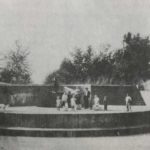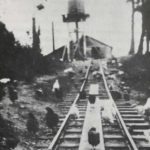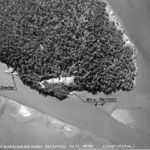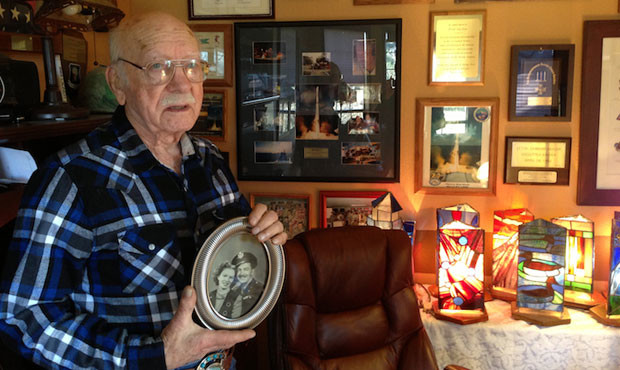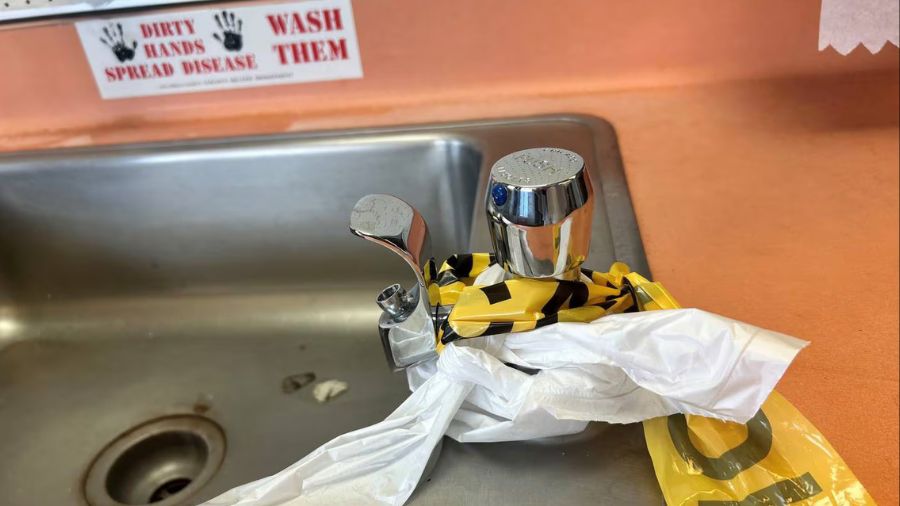Little-known Fort Whitman has been hiding in plain sight
Mar 27, 2019, 8:45 AM | Updated: 11:21 am
Pretty much everybody knows about Fort Casey on Whidbey Island or Fort Worden near Port Townsend. But almost nobody has heard of Fort Whitman.
And that includes me, until a KIRO Radio listener named Tom Leahy emailed a few weeks ago, describing the long-abandoned US Army post that once sat astride tiny Goat Island in Saratoga Passage, not far from LaConner in Skagit County.
Leahy told me that he first stumbled across Fort Whitman — which is named for 19th century missionary Marcus Whitman — back in the 1980s.
“I was at the Skagit County Museum in LaConner and they had a copy of that book that a son of an officer [who had been stationed at Fort Whitman had] wrote. I was looking through it there and said, ‘My gosh, I’ve kayaked by there numerous times,’” Leahy said by phone a few days ago.
“You’d never know there was a fort there,” Leahy continued. “So it was always on my to-do list, and in the mid 1980s I got sick, and that was the end of my kayaking.”
“It’s just something that’s always intrigued me,” Leahy said.
RELATED: Long-lost Fort Tilton once stood guard over Snoqualmie Valley
RELATED: How Washington got the name ‘Evergreen State’
Tom Leahy regrets it now, but he never did buy that book he saw all those years ago, and it’s been out of print for years. Still, the notion of a forgotten fort on a hard-to-reach island stuck with him.
Hearing Tom’s story, I was instantly hooked, too.
My first step was to get on eBay and buy a copy of the phantom book. It’s a charming self-published volume from 1983 called “Fort Whitman on Puget Sound, 1911 to 1945.” It was researched and written by an amateur historian and author named Harland Eastwood, Sr. Eastwood’s father, Thad Eastwood, was stationed at Fort Whitman in the years leading up to the first World War.
While I camped by my mailbox and waited for the book to arrive, I phoned my go-to guy for all things “coastal defense” — an employee of the Washington State Department of Parks and Recreation and amateur historian named Matthew Bell.
KIRO Radio listeners might remember hearing from Matthew last year in a story about the big guns on display at Fort Casey. It was no surprise that Bell knew exactly what I was talking about when I mentioned Fort Whitman, and that he had even paid a visit there.
“It’s actually been a number of years since I went out there, probably within the last five years,” Bell said. “I will say that if anyone else is interested in it, I have some top tips of how not to do it, and that would be don’t go in a canoe rowing against the tide both directions, because that’s the method I chose.”
Fort Whitman, Bell told me, was an adjunct to the three big forts that are now within state parks — Fort Casey, Fort Flagler, and Fort Worden — that in the late 19th and early 20th century formed a “triangle of fire” in the form of artillery defense around the entrance to Puget Sound. In those years, the US feared the Russians or the Japanese or some other great naval power might attack.
So why in 1909 did they build a little fort right there between Whidbey Island and LaConner?
Matthew Bell says that somebody figured out that if the enemy went through Deception Pass to sneak down the east side of Whidbey Island to attack targets such as Bremerton or Seattle, Fort Whitman, with its four six-inch guns — an installation that was officially known as “Battery Harrison” – and its remotely-fired minefield, would be the only way to stop them.
And in spite of all that paddling against the tide, Matthew Bell says Fort Whitman is a pretty cool place to visit.
“There was a rope tied up on the hill that you could kind of use to scramble up from the beach and get up there, and it’s quite incredible, because it’s a place that time forgot,” Bell said. “There’s not a lot of visitors, not a lot of foot traffic on the island.”
And what, exactly, is left of Fort Whitman for those small numbers of visitors to see?
The four six-inch guns are long gone, says Bell, taken away decades ago and ultimately scrapped at the US Army’s Watervliet Arsenal in New York State.
“[But] you can still see the Fire Control Station” says Bell, where the guns were. “There’s some remnants of the wood of the walls, [but] the roof has completely collapsed upon its own weight and it’s fallen in,” Bell said. “The latrine was still there, but I think local teenagers have destroyed all of the toilets and things like that, and I think all the doors are gone.”
Bell says that much of the concrete of Battery Harrison – named for Colonel Francis Harrison of the Second Coast Artillery, who died in 1909 – is covered with graffiti.
“I think that has kind of become a popular party spot for younger people going out there for the weekend,” Bell said. “So it’s a little torn up.”
Matthew Bell is pretty serious about the studies and the travel he regularly undertakes to learn more about coastal defense history, which clearly helps him put Fort Whitman’s unique setting and current condition in perspective.
“I’ve been to the Philippines to look at coast artillery, and I’ve been all around North America … and I have to say that [the condition of] Fort Whitman on Goat Island was much closer to being [like a fort] on the Philippines than it was like anything else I’ve seen in the United States,” Bell said.
Bell says that the big guns of Whitman and the other better-known forts around Puget Sound were pretty much obsolete before the time of the First World War, but Goat Island was still used by the Army up through World War II.
In the late 1940s, pretty much everything that wasn’t nailed down or made of concrete was removed, and the bulk of the property, except for a gravel pit, was handed over to the State of Washington. Since 2004, the entire island has belonged to the state.
A book about Fort Whitman
Harland Eastwood, Sr.’s book about Fort Whitman arrived in the mail only a few days ago. It’s easy to see why Tom Leahy was so enthralled with it, and it strikes me that the $35 I paid on eBay now seems like a wise investment.
In addition to dozens of diagrams and photographs, the book inspired me to track down the late author’s son Harland Eastwood, Jr. Eastwood the younger is a historian and author who lives in Moses Lake.
Eastwood said the book was a labor of love for his father, and that Fort Whitman had played an outsized role in his dad’s life. The two often talked about the island and the fort, including when they boated past it in the 1950s and 1960s. Harland Eastwood, Jr. says that in those days, he would have loved to have stopped and gone ashore, but he swears the island was clearly marked then with “no trespassing” signs.
Still, boating past the 158-acre patch of land in the middle of Saratoga Passage inspired the elder Eastwood to share stories of his time as a boy on Goat Island. Between 1911 and 1917, he lived with his parents and siblings in the caretaker’s house at Fort Whitman.
Oftentimes, in spring and fall, the elder Eastwood’s Army sergeant father would row him across the bay in the morning to attend school in LaConner, and then return to row him back home in the afternoon. In winter, mom and the three kids would move off the island and into town.
At any time of year, Fort Whitman on Goat Island was a pretty amazing place to be a kid.
“I think my dad thought [living on Goat Island] was the greatest thing that ever happened to him,” Harlan Eastwood, Jr. said.
“They somehow got some type of a steam donkey up at the top of the hill and set up more or less a tramway, a little temporary railroad track, and they hauled those great big guns up there to set them in place,” his father told him, Eastwood said.
Harland Eastwood, Jr. says that his father also talked about “the fact that my grandmother wasn’t much of a cook, and they had chicken about six-and-a-half days out of the week … There were wild chickens on the island, and so she would just go out and catch a chicken and chop its head off and put it in a pot and boil it.”
“My dad got real tired of the boiled chicken,” Eastwood said, chuckling.
Harland Eastwood said that his late father would be very happy to know that we were talking on the radio about Fort Whitman in 2019, more than 100 years after his time there. He was apparently a man of few words, but his son says that all this attention for Fort Whitman would’ve put a big smile on his dad’s face.
Visiting Goat Island and Fort Whitman
Goat Island, where Fort Whitman is located, is open to the public, but it can be difficult to access. It is now part of the Skagit Wildlife Area, which is public land managed by the State Department of Fish and Wildlife (DFW). In an email on Tuesday, Belinda Rotton of DFW wrote:
This is not a site that we actively manage or encourage public access in order to preserve the wild nature of the site and the historic features. We are aware of the value of the history of this site but also have some concerns about the public use until some of the features can be secured. Management of these types of features is outside of our local expertise.
For armchair adventurers who’d like to get a peek at Fort Whitman, there’s always YouTube.
Share Your History
Got an idea for a story? Is there a local historic place you’ve always wondered about, or do you have a story that you’d like to share? Send email to KIRO Radio historian Feliks Banel fbanel@kiroradio.com.


